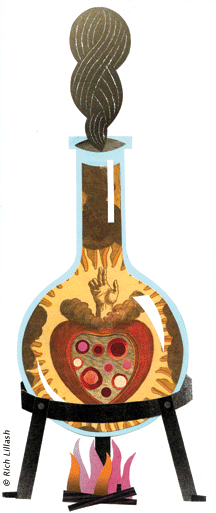
By the Skin of the Heart…
Medieval alchemists sought to transform base metals into gold. Molecular biologists seek to transform one kind of cell into another. There are established ways to do this—the pluripotent-stem-cell approach being the most well-known—but also a demand for simpler, more elegant methods. In July, researchers at the Perelman School of Medicine became the first to demonstrate the direct conversion of skin cells (as well as brain cells) into heart cells by RNA transfer.
The method—called Transcriptome Induced Phenotype Remodeling, or TIPeR—was developed in the lab of James Eberwine, the Elmer Holms Bobst Professor of Pharmacology, in a collaborative effort between researchers spanning multiple disciplines. (The lead author on this latest study, which appeared in Proceedings of the National Academy of Sciences, was postdoctoral fellow Tae Kyung Kim.) “What’s new about this approach for heart-cell generation,” Eberwine said, “is that we directly converted one cell type to another using RNA, without an intermediate step”—like dedifferentiating cells into a pluripotent state and then having to use growth factors to redifferentiate them into a desired form.
The heart cells created via TIPeR could potentially be used to screen the effectiveness of drug treatments on an individual basis, or as therapeutic agents themselves. In the more immediate future, however, the process represents one more step in the fundamental science of cell transformation.
… And By the Tail of the Skin
Some skin cells, it turns out, aren’t much easier to foster in the laboratory than heart cells. Melanocytes, the pigmented cells that make freckles—and, more crucially, absorb ultraviolet light to protect the skin from its damaging effects—are a prime example. But in the December issue of the Journal of Investigative Dermatology, a team led by Xiaowei Xu, associate professor of pathology and laboratory medicine, reported success in creating melanocytes from cells gathered from mouse tails.
Xu and his colleagues pulled off the transformation by using inducible pluripotent stem cells as an intermediary. Xu called the method “an early step” toward possible clinical applications in the treatment of melanoma, the most dangerous form of skin cancer, which is caused by changes in normal melanocyte functioning.
Low Birth Weight, High Autism Risk
Premature birth has emerged as a risk factor for autism spectrum disorders (ASD), primarily on the basis of retrospective studies. In the first study to track a low–birth weight cohort from infancy to early adulthood using validated diagnostic tools for ASD, researchers at the School of Nursing found that babies born weighing less than 4.4 pounds were diagnosed at approximately five times the rate of the general population. The study, led by Jennifer Pinto-Martin, the Viola MacInnes/Independence Professor of Nursing, appeared in an October issue of Pediatrics.
Prematurity is a risk factor for a wide range of cognitive and motor disabilities. But as the survival and longevity of premature infants improves, treating them for nonfatal impairments gains importance. “If there is suspicion of autism or a positive screening test for ASD, parents should seek an evaluation,” Pinto-Martin said. “Early intervention improves long-term outcome and can help these children both at school and at home.”
—T.P.

